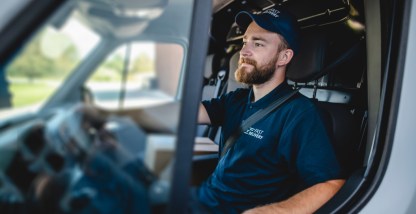Jennifer Kolb, VP of Business Development at Tallo, has spent a decade in the workforce industry. Recruiters can do more to attract young talent, she says. Here’s how.
Trucking plays a central role in the U.S. economy. If ever there were doubts about that, the pandemic cleared them up. There’s just one problem. Drivers are aging out. A 2021 infographic from Coyote Logistics shows that 80% of America’s truck drivers are 45 or older. Another 23% are over 55. The transportation industry needs to bring new drivers into the fold. Fast.
Tallo, an end-to-end ecosystem for workforce solutions, is alleviating the driver shortage by connecting the next generation of talent to promising careers. In an exclusive interview with Motive, Jennifer Kolb, Tallo’s VP of Business Development, says recruiters must connect with Gen Z students earlier, more strategically, and through messaging that attracts a more diverse pool of candidates.
As a professional in the recruiting space, Kolb offers creative ways to answer Gen Z’s most pressing questions and engage with this sought-after talent pool.
What Gen Z knows about trucking
In the survey How Logistics and Trucking Companies Can Connect to a New Generation of Drivers, Tallo asked 21,000 high school and college-aged students what they thought about trucking and logistics. Of the respondents, 18% expressed interest in a driving career and 42% were undecided. For recruiters, that’s a lot of untapped potential. Recruiters must lock in the interested group and influence the undecideds.
“Changing the perception of trucking comes down to better education, better marketing, and more diverse messaging,” Kolb says. “Sixty-three percent of students surveyed are unfamiliar with trucking careers, and 94% have almost no knowledge of them.”
Time away from home and safety concerns topped the list of reasons that Gen Z wouldn’t pursue a trucking career. Fifty-eight percent said they’re deterred by long workdays. To attract young talent, Kolb says recruiters must refine their messaging in the ways discussed below.
When Gen Z says, ‘I don’t want to spend time away from home’
“When candidates raise concerns about spending time on the road, it’s an opportunity for recruiters to break the stigma behind driving,” Kolb says. “If lack of home time is a sticking point for candidates, don’t hide from it. Put it out there. Tell drivers, ‘You’ll be gone these days and home these days, but you’ll be home more than you’re gone.’”
When candidates say they want to be home, it’s an invitation for recruiters to talk about the variety of driving jobs out there. Driving isn’t a one-size-fits-all profession. Still, the industry is dogged by the perception that all driving careers are long-haul routes.
“Local drivers are home every night and on weekends,” Kolb says. “Drivers on dedicated routes get ample home time. So do last-mile drivers like UPS and FedEx couriers. There are plenty of options for people who want to drive and return home every night. To change the perception of trucking careers, the industry needs to be talking about a diversity of opportunities, even if the greatest need is in long haul. Promoting a diversity of driving roles is Step 1 to attracting young talent and getting more people in the door.”
When Gen Z says, ‘I’m concerned about road safety and traffic congestion’
If Gen Z values safety, they also appreciate cloud technology that’s mobile and easy to use. As the transportation industry becomes more reliant on technology, Gen Z will see digital transformation as an asset.
“Recent high school and college grads expect to work with technology,” Kolb says, “If your company uses AI dash cams and collision avoidance tools, for example, you’ll appeal to these candidates that much more. Especially if you have someone on staff to demonstrate how the technology works.”
Gen Z has been using technology since kindergarten. They grew up working with tablets and smartphones. “So any tech that protects drivers from accidents or helps them work faster could attract early talent,” Kolb says. “If you have cool technology that enhances safety performance, productivity, and efficiency, Gen Z will be drawn to that.”
When Gen Z says, ‘I want a better work-life balance’
In the Tallo survey, 31% of Gen Z respondents said work-life balance is most important in a future employer. Another 23% said job fit is most important. “If logistics and trucking companies can help employees strike a balance and ensure they get the right skills, hiring and retention will become easier,” the Tallo report states.
Companies can honor Gen Z’s safety concerns by offering safety technology and insurance. Create growth and training opportunities to help employees advance their careers. Pay drivers well. Offer bonuses. And provide paid time off to promote a healthy work-life balance.
“Better yet, show candidates what a day-in-the-life looks like through corporate marketing videos,” Kolb says. “Visuals speak louder than words. Create polished videos with really strong messaging. Talk about the different driving routes and schedules available. Maybe night owls can drive at night or owner-operators can create their own schedules.
“The only way candidates are going to know about these options is if recruiters talk about them,” Kolb continues. “Post the videos on your home page and social media channels. Give young candidates a chance to see themselves at your company.”
Participate in student career days
Why wait for the next generation to come to you, Kolb says. Bring the profession to them.
“A big part of the work-life balance conversation is allowing students to experience the vehicle. Enterprise-level companies that have the resources and capacity to bring a semi or flatbed to a high school for career days should absolutely do it. The transportation industry needs to create more opportunities for students to climb into the vehicle, sit in the driver’s seat, and connect with the space.”
Use career days to educate students on the full scope of driving responsibilities, from pre-trip checks to drive time. Tallo’s survey shows that about 60% of high school and college-aged students will engage in Q&A sessions to learn more about transportation careers. And 54% of them will try a day-in-the-life program. So don’t be shy about hosting programs that give them a closer look at the profession.
Promote diversity, equity, and inclusion
“Whether posting a video to your website, building advertising content, or taking the vehicle right to a high school, make sure the people featured in your marketing are diverse and engaging,” Kolb says. “This is crucial. Fleets are feeding the stereotype by not featuring diversity in their marketing. If you have a diverse group of people talking about driving careers, you’ll attract more diverse applicants.”
Feature drivers who are willing to talk about what they love, Kolb adds, because people feel drawn to engaging stories. Like this UPS commercial. “A little girl connects with the driver and wants to be like her,” Kolb explains. “She wears a little brown suit, rides in a miniature truck. It just goes to show that the face of your company has the power to inspire people to think differently about an occupation.”
Connect with young talent early and often
In working with industries beyond transportation, Kolb has seen that an “early and often” approach can be most effective. According to Tallo’s data, 37% of early talent decide on careers junior year of high school. Another 43% of them decide senior year. Nearly 75% of early talent job seekers say they’re more inclined to work for employers who connect with them prior to the job search.
“It’s a big advantage to have a consumable product, such as Gatorade or Pepsi, because candidates are already familiar with the brand,” Kolb says. “Trucking isn’t a consumable product. So when we say ‘early and often,’ Gen Z is only thinking of brands they know, like Apple, Google, Amazon. To start cultivating that pipeline of young talent, you have to get your brand out there. If a 20-year-old is seeing your logo for the first time, you’re already behind the eight ball in recruiting them.”
So whether it’s sponsoring the local baseball team or joining associations, it’s important to have a brand, a culture, and keep getting your message out there. “Be invested in community events, because those are the efforts that connect with people emotionally,” Kolb says.
Provide ‘right now’ jobs through strategic partnerships
The trucking industry is most concerned about the gap years between 18 and 21. That’s because high school students generally graduate at 18, and drivers can’t drive across state lines until 21. That’s a three-year gap in the workforce that the industry has struggled to address. Fortunately, Kolb offers a viable solution in the form of “right now” jobs.
“It’s important that the trucking industry ponders strategic partnerships to fill that three-year gap,” she says. “Take one of the largest e-commerce stores, where at the entry level, if a worker has not advanced in three years, they’re let go. If there were an industry for commercial fleets to partner with, these workers could be feeding the pipeline. Someone could work in packing and receiving for three years. After that, they know they’re going to be driving a truck. There’s a lot the industry can do, so don’t think of these as ‘gap years’ or ‘wasted years.’
“Instead, put young workers in jobs that will make them better drivers,” Kolb continues. “Turn gap years into critical skill-building years, where young people are making good money, building relationships, and being prepped for the next stage of their career. Then at 21, they can go on to drive an 18-wheeler.”
If companies wait until students are 21 to connect, it’ll be too late to influence their paths. Still, companies need talent now, and high school students won’t be ready to work for years. If that sounds problematic, make a plan.
“The best time to start developing a long-term talent pipeline was 10 years ago,” Kolb says. “The second best time is today.”
Workforce development doesn’t have to be so hard. Get more great recruiting insights from Jennifer Kolb in our on-demand webinar.









